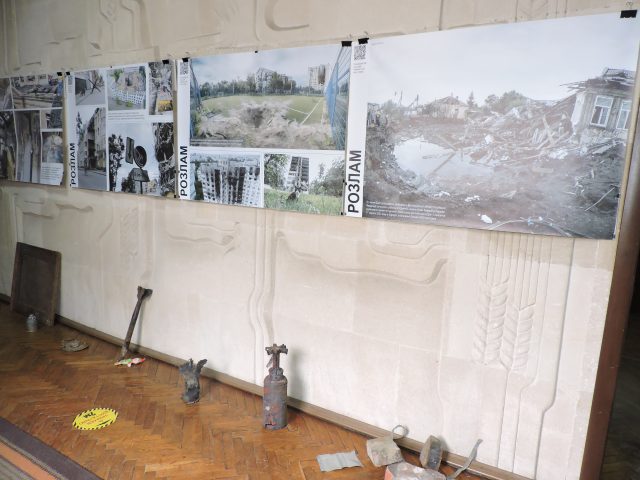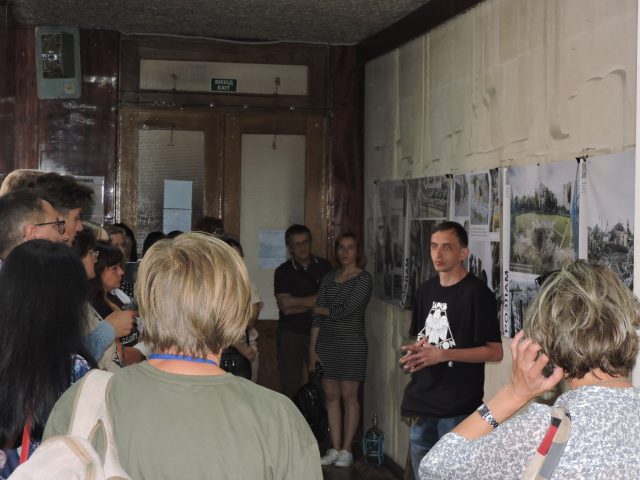On September 1, 2022, at 3:00 p.m., the documentary exhibition “The Kharkiv Fracture” opened in the Berezhany Museum of Local History. The authors of the photo talk about various aspects of the destruction in Kharkiv, which has been suffering from Russian artillery shelling and rocket attacks every day since February 24, 2022.
What is “The Kharkiv Fracture” photo exhibition about?
“Kharkiv Fracture” is about the break of culture, education and human destinies after February 24? 2022. This exhibition tells about what the “Russian world” (Russkiy Mir) brings to Ukraine. It means for us Russian shells and missiles, and that is what Kharkiv and other cities near the front line are going through,” Serhiy Petrov, one of the authors of the photographs and co-organizer, said at the opening of the exhibition. He is a member of the “Maidan Monitoring” team documenting the civil infrastructure destruction and the author of “Kharkiv Chronicle”. Petrov lost his home in Northern Saltivka due to Russian shelling.

Photo: Serhiy Petrov, CC BY-SA 4.0
The team of the “Maidan Monitoring” Information Center was able, based on the inspected objects, to classify the objects that became targets for Russian troops. These are schools, kindergartens, any educational institutions, hospitals, transport depots, public transport stops or even rails, sports facilities, water pipes, gas pipes, electric substations, telecommunication cables – in general, the entire infrastructure of the city. According to Serhiy Petrov, the documentation materials also formed the basis for the criminal proceedings conducted by law enforcement agencies.
The Russian shelling of Kharkiv is based on the policy of urbicide
“The basis of the Russian shelling of Kharkiv is the policy of urbicide – the destruction of social infrastructure, the transformation of the territory of the city, the village into an uninhabitable space and the creation of conditions forcing people to leave this territory. This is a policy of depopulation, when parents leave with children, young people, and in such cities only some residents remain and they degrade. This is a policy of acoustic and psychological terror – these are shelling, and especially night rocket strikes, which since May 23 have been carried out every night in the city and suburbs and can happen at any time: whether at 9 o’clock in the evening or at 5 in the morning, when it is dark and people are poorly oriented in space. This is terror for suppressing resistance, psychological pressure and violence, this terror is the control of human sleep and emotional state,” said Serhiy Petrov during the opening of the Rozlam exhibition. Kharkiv.

During the opening of the exhibition, Mykola Protsiv, deputy director of the Berezhany Museum of Local History, noted that there are many parallels between Kharkiv and Berezhany. Kharkiv, which has one of the largest squares in Europe, and Berezhany, which has one of the smallest squares in Europe – St. John Paul II Square, so small that a monument to him did not fit here. Kharkiv is the city of the “Berezil” theater founded by Les’ Kurbas, whose father studied at the Berezhany Gymnasium. Kharkiv is the city of the Euromaidan Forum on January 11-12, 2014, which was attended by four citizens of Berezhany. Kharkiv and Berezhany are united by Skovoroda, who was a teacher at the Kharkiv Collegium and whose portrait was painted by the teachers of the Berezhany Gymnasium.

Photo: Volodymyr Berezin, CC BY-SA 4.0
The team of Maidan Monitoring Information Centre helps displaced persons and refugees on volunteer basis to find out about the condition of their houses.
One of the authors of the exhibition conducted a tour of the exhibition and told about the proximity of Kharkiv to the Russian border. That is the reason why the city can be shelled directly from the territory of the Russian Federation. In particular, that the team of the Maidan Monitoring Information Centre helps displaced persons and refugees on volunteer basis to find out about the condition of their houses. You can submit a request to one of the team members on Facebook or in another way (see the link how to do it exactly).
The exhibition presents 35 photographs of the destruction of educational and cultural institutions, architectural monuments and memorials, residential buildings, and sports grounds. Photos were taken by a team of war documentaries of the Maidan Monitoring Information Center from March 10 to August 19, 2022.

A separate exhibition is devoted to the most destroyed district of Kharkiv – Northern Saltivka, where about 100 thousand people lived before the beginning of the large-scale invasion. To strengthen the exhibition, the employees of the Berezhany Museum of Local History supplemented it with various objects: a brick, a piece of door decoration, children’s toys, fragments of ammunition brought by volunteers from the east of Ukraine, and the remains of burned book.
Why did “Kharkiv Fracture” exhibition traveled to Ternopil Oblast?
Ternopil Oblast is designated as one of the places where displaced persons from Kharkiv Oblast will be resettled in case of the forced evacuation. Therefore, as Serhiy Petrov noted, this exhibition should give residents of Berezhany an opportunity of better understanding what the residents of Kharkiv have gone through. What kind of psychological injuries do they have, caused by constant life under shelling and missile strikes.
Oleksa and Oksana Muravlyov, displaced persons from Kramatorsk, who were forced to leave their home for the second time since 2014, spoke during the opening. They currently live in Berezhany, and they recalled that the Russian-Ukrainian war has been going on since 2014. The aggression of Russia is multidimensional and multi-component.
On August 31, the English-language version of this exhibition was opened in Prague during the “Forum for Ukraine”, which took place within the framework of the meeting of the ministers of foreign affairs of the EU countries.
The exhibition is organized by the team of the Maidan Monitoring Information Centre (curator – Nataliya Zubar). The co-organizers of the exhibition were the international organization Team 4 Ukraine, the NGO “Berezhanskiy Maidan” and the Berezhanskiy Museum of Local History.
The project that enabled Kharkiv Fracture exhibition is supported by Crown Agents International Development.




